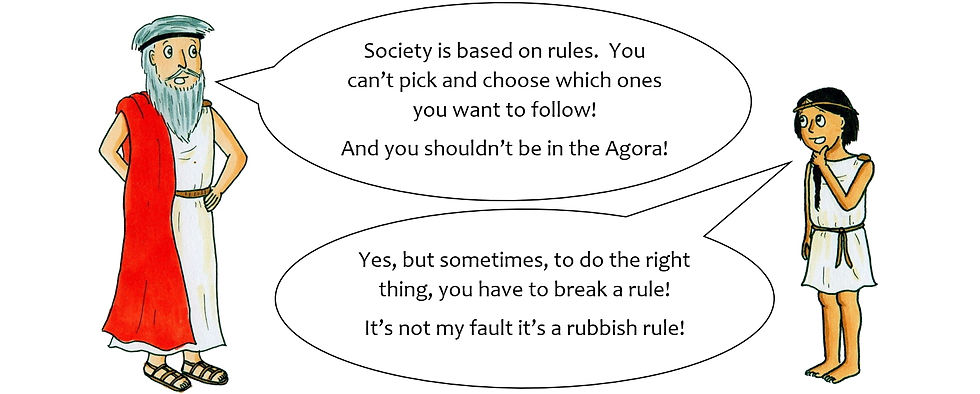
Agora
Central Stoa
Slavery in Ancient Greece




Delphi, as always, had to be quick. She ducked past a few stalls set up that morning, and ran towards the edge of the nearest stoa. Shouting followed her, but there was always shouting here, and it got lost in the noise. Delphi slumped against a wall and got her breath back. Then, she grinned. She loved this place.
You could buy anything here. Any food, any furniture, any perfume. Anything. Products came from all over the world, and not just objects. Delphi could see the huddle of people gathered around the city’s main slave market. You often saw slaves doing the shopping in Athens, but she had never really felt that comfortable about seeing other people buying them. But that was just what happened in Athens. She looked the other way instead and the excitement came rushing back to her.
It was truly the centre of the world. Indeed, the Altar of Twelve Gods, which sat in the square in front of the Temple of Ares, was the point used to measure distances to all other places. All roads seemed to meet here. Look up and you can see the Acropolis, the Areopagus, the Pnyx. Look around and you can see everything else Athens is. The Agora was the beating heart of Athens – but it said a lot about Athens that she wasn’t welcome here, and never would be. Girls weren’t supposed to be in the Agora.
She took a breath and wondered which way to go.



Agora Central Stoa: Fact box
-
We don’t have anything quite like an Agora these days. It was a mixture of a marketplace and meeting place while also containing many important religious and government buildings. It was the place Greek citizens went to serve their country, say their prayers and do their shopping. A stoa was a covered walkway. You can see a restored stoa in the background of the photo at the top of this page.
-
Because it was seen as such an important place, only Athenian citizens were allowed to enter – meaning women, children and foreigners weren’t allowed in. However, slaves would often do the shopping for their masters and there are one or two suggestions in ancient sources that suggest this rule wasn’t always strictly enforced.
-
The Agora contained many permanent and temporary shops, stalls and markets, selling all sorts of products like oil, wine, fish, perfume and clothes. There would also have been a large slave market here.
-
The Athenians used coins to do their shopping, which was quite unusual in ancient times. The most famous coin is the Athenian Silver Owl – a coin stamped with the head of the goddess Athena and her sacred bird, the owl. Silver was one of the main sources of wealth for Athens, as there were large slave-worked silver mines in the mountains nearby.

-
At the centre of the Agora was a water clock. This was a simple machine that was basically two big jars on top of each other. When the sun came up, the cork would be pulled out the top one and let a trickle of water flow into the bottom one. It took about 17 hours for the jar to empty, so you could see what time it was by seeing how much water had poured out. Of course, the Greeks didn’t have clocks or watches back then!
Slavery in Ancient Greece
-
It is perhaps a bit sad to us now, but Ancient Greece was very much a society built around slavery, in a way that we would find horrible today. Slavery (the ownership and control of other people) was very common at this time, and every major civilisation at this time used slaves.
-
Slaves usually came from foreign lands. When the Athens' army won a battle or conquered a city, the defeated people would often be taken as slaves and then sold.
-
Life as a slave was often incredibly tough. They would have to do the most unpleasant or dangerous jobs, like silver mining or working the fields. However, there were also more educated and respected slaves who worked as jobs like teachers or childminders.

-
Athens had a massive slave population. During the Greek Classical Age, there could have been as many as 100,000 slaves in the city – that’s more than a quarter of the entire population at the time!
-
Although there were some critics of slavery, it was seen as so normal to have a slave, and the Greeks relied on them so much, that the idea was never really challenged until Christianity came to Greece during the Roman era.




